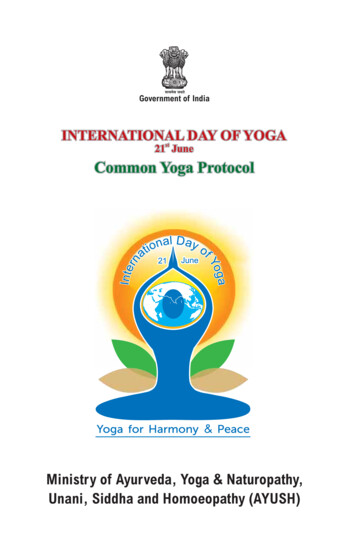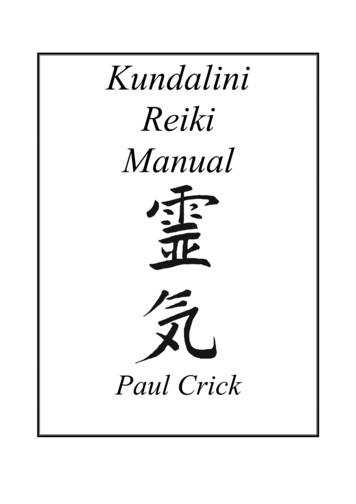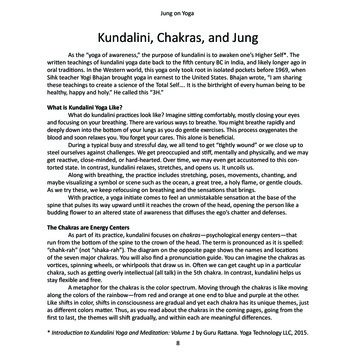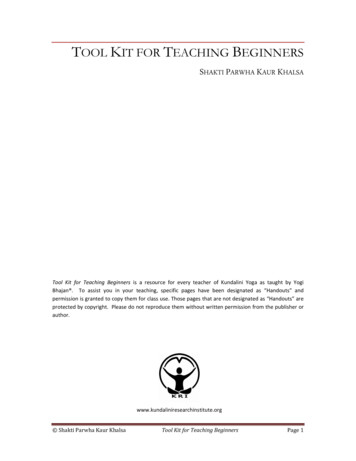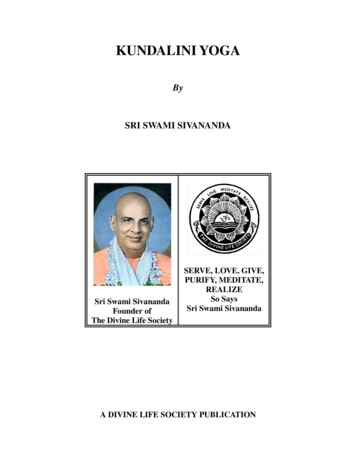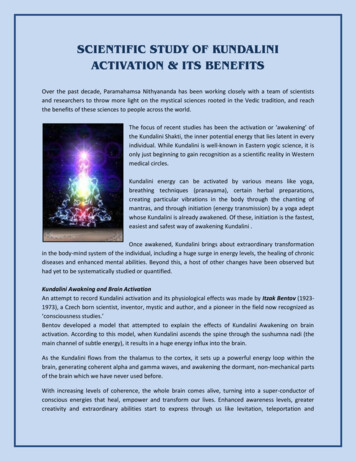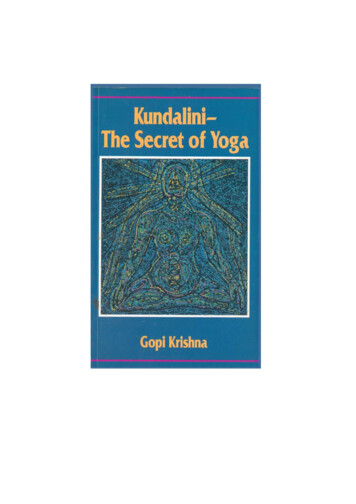
Transcription
Kundalini The Secret of YogaGOPI KRISHNAPublished byF.I.N.D. Research TrustandKundalini Research Foundation, Ltd.
Kundalini - The Secret of YogaCopyright 1972Gopi KrishnaFirst printing 1972Second printing 1990Published by:F.I.N.D. Research TrustR.R. 5 FleshertonOntario, CanadaNOC lEOThe Kundalini Research Foundation, ltd.P.O. Box 2248Noroton HeightsCT. 06820U.S.A.Published in association with:Kundalini Research Association InternationalKundalini Research and Publication TrustKundalini Research AssociationGemsenstrasse 7,8006 Zurich, SwitzerlandBioenergy Research Foundation1187 Coast Village Road, 1-186 Santa BarbaraCA. 93108., U.S.A.First F.I.N.D. Research Trust editionSecond Kundalini Research Foundation, Ltd.editionInternational Standards Book Number:06-064787-6Library of Congress Catalog Card Number:77-184409Cover painting:A New Jewel by D. Joan Woo
ContentsIntroduction(i)1 The Aim of Yoga12 How This Aim Is Achieved213 Kundalini, Fact and Fiction444 Yoga, True and False675 The Discipline of Yoga916Kundalini, the Key to Cosmic Consciousness1137 The Biological Aspect of Kundalini1348 The Physiology of Yoga1579 The Harvest: Transcendence, Genius, and Psychic Powers180Appendix204About the Author208Index209
OTHER BOOKS BY GOPI KRISHNAKundalini, The Evolutionary Energy in Man(An Autobiography)The Biological Basis of Religion and GeniusThe Awakening of KundaliniThe Riddle of ConsciousnessThe Dawn of a New ScienceSecrets of Kundalini in PanchastaviYoga, A Vision of Its FutureThe Real Nature of Mystical ExperienceKundalini in Time and SpaceThe Shape of Events to ComeReason and RevelationThe Present CrisisThe Way to Self-knowledgeFrom the UnseenThe Wonder of the BrainKundalini for the New Age
IntroductionThere are few subjects relating to spiritual development socritically important and yet so incompletely understood as Yoga.Although the interest in Yoga that started in the West during the1960’s has abated to some degree, the teaching of the variousforms of the discipline has become well-established. In manycases, those who practise Yoga as it is generally taught in the Westdo so primarily as a means to improve health, reduce stress ormaintain physical fitness.The other aspect of Yoga given much attention is the controlover the physical body that can be gained by long practice of itsphysical disciplines. Sensational accounts of yogis who canperform amazing feats of bodily control, such as suspension ofbreathing for extended periods of time, conscious control of theheartbeat and the ability to increase body heat in freezingtemperatures get wide publicity. There are stories of yogis who canfly, live to an advanced age or perform amazing psychic feats.Although these stories are, for the most part, never properlyverified, the general impression exists, both in the East and West,that Yoga can bestow magical or occult powers on those who learnits deepest secrets.But, as Gopi Krishna points out, there is much more to Yogathan its benefits to health, control over the body and potential fordeveloping paranormal abilities. The significance of Yoga, and thepurpose for which the discipline as a whole was really designed,lies in its potential for enabling the practitioner to actuallyexperience expanded states of consciousness and(i)
INTRODUCTION(ii)to verify the existence of levels of creation other than the one weperceive with our material senses. The other benefits are minorwhen compared with the real goal.Part of the reason for this lack of understanding is that in theWest, Yoga is rarely presented in its complete form. Aspects of thedisciplines which are critical to achieve real success, i.e., abalanced lifestyle, self-discipline and control of the senses, are notalways emphasized, or if emphasized, they are not followed.Because the primary goal of Yoga is understood in such a limitedway, few people who take up the discipline are willing to make theeffort essential to real success and the potential for attaining highlyenhanced states of perception remains largely untapped.Another important aspect of Yoga is that if Kundalini, whichGopi Krishna claims is at the heart of the discipline, is the energyresponsible for spiritual experience and mystical states ofconsciousness, then two logical conclusions can be drawn: 1) allreligious experience owes its origin to this source and 2) thesystematized discipline of Yoga corroborates the basic beliefs ofreligion which heretofore could only be accepted on faith. They areverifiable by personal experience. So, Yoga can provide a methodthat alleviates the discord and rivalry that exists between theadherents of the major faiths and also a foundation for thedevelopment of a more broadly-based scientific method that couldreduce the long-standing conflict between science and religion.Another reason for the need to properly study and understandYoga is the occurrence of what is currently known as ‘SpiritualEmergence.’ This term is generally used to describe a set ofphysical and psychological symptoms which are experienced forvarying periods of time and, if handled in a proper way, can resultin enhanced levels of awareness, creativity and mental well-being.But some of the symptoms experienced in these cases resemblecommon forms of psychosis, and treatments done on this basis canbe detrimental both to the process and to the mental and physicalhealth of the individual.For those who approach these processes with an open mind andwho attempt to help the people who experience them there can beno doubt about the reality of the suffering that many of themendure, often unnecessarily. But until the physiological basis forthis condition is actually determined and understood, it will not bepossible to make substantial progress either in helping the peoplesuffering from severe problems related to these processes or inmaking Spiritual Emergence a valid and accepted branch ofmedical study.
(iii)INTRODUCTIONIt was Gopi Krishna’s belief that the only way to establish thereality of spiritual experience on a firm scientific basis is toconduct research into the biological factors that are responsible forit. The discipline of Yoga, with its systematized and highlydeveloped methods for enhancing the processes that lead to higherlevels of consciousness, is the natural centre around which thisresearch can proceed.Although not a Yoga teacher by profession, Gopi Krishna’s morethan 45 years of experience with the effects of a fully awakenedKundalini and the thorough research of the subject done during hislifetime gave him the insight and knowledge necessary for theunderstanding of this vast subject. The meticulous study of his owncondition and the information that he gathered can be of invaluablehelp in undertaking a project of this kind.If his theories about the nature of spiritual experience are verifiedby the research that he recommended, it will bring about arevolution in our understanding of the human condition and of thegoal towards which the human race is currently evolving.Michael Bradford
1The Aim of YogaThe great interest evinced in Yoga and other occult doctrines bya large number of people, both in the East and in the West, is aclear indication of a growing thirst in men to know more aboutthemselves, their birth and death, the real nature of the consciousprinciple animating them, and about the mystery surrounding theuniverse. There is nothing new in the expression of this impulse. Ithas been present in various forms from the day man began to leadthe life of a rational being, from the day he began to use stoneimplements, of the crudest type, and to live a family and social lifeof the most primitive kind. That the thirst has always been presentin one form or another is corroborated by the earliest relics ofprimitive men found in different parts of the earth. Undoubtedlythere is a difference in the intensity of its expression and the formof its manifestation, but that the thirst has not abated is clearbeyond the least shadow of doubt.There appears to be a misconception in the minds of some peoplethat Yoga offers an easy and convenient method for gaining accessto the occult. This notion is especially prevalent in the West, andthe idea persists that there are secret practices which can workwonders in leading men to the realm of the spirit. Such aconception is not peculiar to this era alone, but, in various1
2THE SECRET OF YOGAforms, has been present from the remote past, ever since primitiveman began to experiment with different methods to gain psychicpowers, to invoke spirits and ghosts, to practice the art of magicalhealing, or to trade in sorcery and witchcraft. The men who practiced or professed these arts were always a source of wonder andattraction to novices desirous of attaining similar powers. The ideaunderlying this belief, which persists to this day, suggests that thereare latent possibilities in the human mind which, when developedthrough appropriate methods, can place at the command of anadept unseen, intelligent forces of nature which enable him toperform extraordinary feats utterly beyond the capacity of normalmen. How far this concept is based on reality and how far it is amyth is the aim of this work to expound.Properly speaking, Yoga is an adjunct to religion and has alwaysbeen treated as such in India, the country of its birth. The wordYoga is derived from the Sanskrit root yuj, which means to yoke orjoin. As such, Yoga signifies the union of the individual soul withuniversal Consciousness or, in the language of the Upanishads,with the uncreated, all-pervading Brahman. In other words, thespiritual practices, classified under the general name Yoga,constitute different methods for the attainment of spiritualobjectives, for verifying the doctrines formulated by prophets andsages, and for experiencing the Transcendent. Yoga is notsomething different or divorced from religion. It is the experimental part of it, offering ways and means to the properly qualifiedaspirants, prepared to undergo the discipline and to follow themethods suggested, to prove for themselves the validity ofreligious doctrines and the results attained by those whosuccessfully pursued the path prescribed.Yoga, as the empirical part of religion, is especially valuable inthis age of reason as the growing intellect of the race demandssome proof for the existence of the Transcendent Reality within theuniverse. Unless and until this proof is forthcoming, even in asubjective form, it will be increasingly difficult to reconcile theintellect with the existing dogmas of religion and agnosticism
THE AIM OF YOGA3will continue to take a heavy toll from the ranks of scholars andmen of science. From earliest times Yoga has provided the answerto the agnostic and the atheist in India. To the question, Can youprove the existence of a reality within the world of phenomena? theanswer has been Yes. How? The answer, practice Yoga and see foryourself. It should not be supposed that India has not had its shareof highly intelligent and vociferous skeptics and atheists. Theyexisted even before the birth of Buddha in the sixth century beforeChrist, and under various guises have continued to spread theirsubversive doctrines to this day. Nevertheless, it is true that in spiteof their opposition, Yoga continued to thrive and to be the chiefinstrument of realization for almost all the innumerable and,sometimes, mutually contending creeds and sects in India, therebyproviding strong evidence of its vitality as well as its efficacy andpopularity even under difficult conditions.The validity of Yoga in its various forms as a tested method forgaining spiritual experience has never been doubted. On the otherhand, the doctrine has remained surrounded by a halo that hascontinued undiminished to this day. Such a halo and suchveneration, as Yoga now commands even in India, could neverhave been possible if from time to time its roots had not beenwatered by men of outstanding genius who brilliantly proved forthemselves and others the possibility of the supreme achievementclaimed for it. Because there exists a galaxy of extraordinaryspiritual luminaries behind it, Yoga has been able to survive theonslaught of centuries and continues to this day to excite thecuriosity and command the admiration of legions who accept it.There is ample evidence to show that the various methods used inYoga were in vogue in India even in the Vedic age, long before thebirth of Patanjali, the renowned author of Yoga-Sutras. To thisgreat savant of the past, however, goes the credit for gathering thescattered threads of this hoary cult and formulating it, for the firsttime, into a methodological system of scientific experimentationand philosophy.Divested of the superstition and myth that surround all reli-
4THE SECRET OF YOGAgions, Yoga contains absolutely nothing that can be abhorrent toany faith or creed. On the other hand, it uses most of the methodsadvocated by the founders of great religions, mystics, and sages asa means to God-consciousness and to render the body a fit vehiclefor spiritual illumination. Despite popular belief to the contrary,Yoga has never been considered to be a shortcut to self-realization.Although some writers on Yoga, even in the past, have claimedextraordinary efficacy for their particular method, the fact remainsthat this ancient system has never been considered as a means ofeasy approach to the Divine. On the contrary, all those whodiligently pursued it did so with full realization that they weretaking up a most serious quest and that they would be fortunateindeed if they attained some measure of success in it in theirlifetime.How seriously the quest is taken in India is, to some extent,evidenced by the large number of men who leave their homes andfamilies to live in seclusion or in the company of masters to followthis path. Their number runs into millions. Apart from them,millions of men in different walks of life in India make Yoga anintegral part of their lives, devoting to it all the time and energythey can spare, and even neglecting their worldly ambitions toachieve success in this enterprise. The life of most of these men isone great sacrifice to this holy quest. They have no delusions aboutthe fact that they have entered upon an arduous undertaking, andhave to submit completely to all the disciplines enjoined. Theyknow that the prerequisites for an earnest study and practice of thisvenerable system are a recognition of this important fact, areadiness to make the sacrifice; and last, but not the least, to makeit a permanent, integral part of one’s life. The present sundrymisconceptions about Yoga, treating it as a treasure house of easyto-follow secret methods to experience the vision, Reality, or thepsychic powers are entirely unfounded and often end in a painfulharvest of disillusionment and frustration.Many of the disciplines and practices of Yoga are common to
THE AIM OF YOGA5all great religions of mankind or, at least, to their esoteric aspects.The main difference is that in Yoga they have been brought into amethodological system divested of other ritual. This gives to Yogathe semblance of an independent cult. The word yoga is met for thefirst time in Vedas in the Katha Upanishad and some description ofit is contained in Svetasvatra, the last of the early Upanishads. It ismore frequently met with in Puranas, the epics and other laterliterature, and is sometimes synonymously used for tapa anddhyana (i.e., religious austerity and meditation). Basically Yoga isnothing more or less than systematized concentration. Fixity ofattention, whether on a God or a goddess, on a symbol or adiagram, on the void or any material object, or whether on amantra or any particular region of the body, is the main exercise ofevery ancient form of Yoga. It is at the same time the invariablymet cornerstone of every religious discipline and occult practiceknown to man. Why it is so shall be explained at other places inthis volume.In one form or another Yoga, mental discipline and physicalexercises combined, has been in vogue in different parts of theearth from time immemorial, forming a part—sometimes a repellent part—of primitive cults and creeds. Some of the unsavourypractices continue to this day, incorporated into obscene rituals andceremonies of some Yoga cults. In the light of these facts it is amistake to treat Yoga as an independent system of exercisesdevised exclusively to bestow peace of mind or access to the occultworld on those who practice it. But rather, it should be taken as avaluable system of tried religious practices, collected and coordinated, designed to form a much-needed adjunct to any religion ofmankind for lending corroboration to the possibility of spiritualexperience.The modern tendency to divide Yoga into several differentdistinct and separate types, such as Karma-Yoga, Jnana-Yoga,Dhyana-Yoga, Mantra-Yoga, and the like, is based on an incorrectappraisal of the circumstances that led to the development of thisscience and an incorrect knowledge of its history. In the
6THE SECRET OF YOGAearliest religious literature of India no such distinction is made. It istrue there must have always existed numerous schools of spiritualculture to cater to the needs of men of different tastes, differentreligious beliefs, different intellectual levels, and at different stagesof moral development; and these schools, as is natural and ashappens even now, must have designated their systems differentlyto invest them with importance and to attract disciples. But thatdifference extended only to the pattern of methods used and not tothe fundamental concept of Yoga.In the Bhagavad-Gita the enumeration of several forms of Yogais an attempt at synthesis and every form has been praised. This isalso clear from the reference made to the identity of sankhya andYoga. In the Gita, from first to last, Yoga is treated as a powerfulmeans toward emancipation, as an integral and essential part ofman’s religious zeal. The same view is taken in other well-knownreligious books of the Hindus. In the course of time the variousmethods of Yoga were also incorporated into the sacred books ofBuddhists and penetrated to Tibet, China, Japan, and other placesin the Far East. The diverse forms of Yoga, in vogue in India fromvery early times, embrace nearly all the methods adopted by peoplein different epochs and of different climes from the crude,primitive attempts made to gain supernatural power of healing,exorcism, black magic, prophecy, and the like to the subsequentsupreme endeavour of spiritual illumination. Broadly defined theterm Yoga can be applied to any systematic effort made by man toeffect the assuagement of spiritual thirst by the use of suitablepsychosomatic exercises out of the vast inventory of methodsmentioned in Yoga texts and other religious documents. The mainthing to be kept in mind is that Yoga is not an accidentallydiscovered royal road to spiritual experience nor the secret treasurehouse of some magically effective methods for gaining uncannypsychical powers. In its diverse forms it is in reality theconglomeration of almost all the methods for the attainment ofsupernormal states of consciousness devised by the religious zealof man. In other words, Yoga, in the real
THE AIM OF YOGA7sense of the term and in the light of the purpose for which it isemployed, is to the supersensory or spiritual part of man whatempirical science is to his visible or physical part.Yoga provides methods for the attestation of spiritual truths, butthe laboratory is the man himself. In this sublime enterprise he hasto experiment upon himself to know the real facts about his ownexistence, or about the entity who never reveals his own nature tohim from birth to the last day of his pilgrimage on earth, and keepshim perpetually mystified about his past and future, a prey todoubts and misgivings from the day he begins to think coherentlyto the end. It never was and never can be a readily availabletalisman to bridge the yawning gulf between the seen and theunseen, between the physical and the superphysical for all andsundry who undertake it. On the other hand, the mental andphysical constitution of the seeker and the diligence and purity ofpurpose with which he devotes himself to the effort are ofparamount importance in determining the measure of success heachieves. It must be clearly understood that Yoga does not provide,as is sometimes supposed, a way of escape from the earthly part ofour lives or a back-door entrance to the Divine for the evasion ofreligious obligations and spiritual responsibilities—speaking inuniversal, not parochial, terms—that devolve on man.Patanjali, in his Yoga-Sutras, introducing the doctrine for thefirst time as a distinct and methodical system of spiritual exercisesand philosophy, defines Yoga as restraint of the fluctuations ofmind-stuff. In other words, it means a condition of mental arrest inwhich the superphysical existence of consciousness, beyond therange of the senses and the mind, becomes perceptible to theinitiate. According to Yoga-Sutras one of the attributes necessaryin the aspirant is Astikta, or belief in God. This belief is not to betaken in any restricted sense. In order to be qualified as an“Astikta,” one may believe in an anthropomorphic God or amultitude of gods or a God without form, or a TranscendentReality in the shape of Brahman or Shiva or Divinity in any
8THE SECRET OF YOGAconceivable mould, but he must believe in Vedas and in the spiritual destiny of man. The followers of sankhya, which does notadvocate a belief in God, but in the plurality of individual soulsand prakriti, or matter, exploit Yoga for the verification of theirown tenets. Similarly Buddhists use it for establishing the validityof their own conceptions that human existence is a series of incarnations not of an individual soul, but of a combination ofelements, until after righteous endeavour it terminates in nirvana orcessation from the cycle of births and deaths.The monotheists, the dualists, and the pantheists in India look upto and use Yoga for the demonstration of their particular spiritualbeliefs and dogmas. The Vedantists practice it to prove that thesoul or Atman and Brahman are one and the phenomenal world isan illusion born of the action of maya, an unfathomable andinexplicable conditioning factor, which envelops the Atman in aveil of myth. The Saivites practice their own forms of Yoga toprove that the universe is the manifestation of shakti, the creativeand active aspect of the Shiva-Shakti combination, the two-in-oneattribute of Para Shiva, the lord of creation, who is both the creatorand the created, by combining the conscious principle and theconscious creative energy in one. In fact, all sects, creeds, andfaiths in India, and there are many of them, depend on Yoga for thedemonstration of their truths and the verification of their variedand, sometimes, diametrically opposed beliefs.It is therefore obvious that Yoga has to be viewed from a broaderangle than is sometimes used at present. Even in recent years theresults attained through the practice of Yoga have been variouslyevaluated and described by the religious luminaries of India. TheVedantists, the Buddhists, the worshipers of Shakti, or Shakts, theVaisnavites and all the rest, who claim success in Yoga, describetheir experience in terms of the doctrines and beliefs of their owncreed. This means that the final state of Yoga, namely, the ultimatecondition of mental arrest or Samādhi, is not always the same butvaries with the individual and the faith he owns. From this itfollows clearly that those who wish
THE AIM OF YOGA9to take up the practice of Yoga, with a definite understanding that itwould lead to such-and-such a condition, and those who foster thisbelief among the people not well versed in the history and theentire application of the system, are not treading on solid ground.This misconception not only leads to wrong endeavour, disappointment, and frustration but also to a tremendous waste of humanenergy. The only reasonable and safe attitude would be to treatYoga as a systematized form of religious striving, needing lifelongattention and sacrifice, for a successful consummation, as hasalways been recognized; but what that consummation would be noone can be sure from the start. If the exercises and the disciplinesenjoined are followed scrupulously one may expect a measure ofsuccess, provided the body and the mind are already in a certainstate of maturity, but what form that success would take, whatwould be the nature of the ecstasy, what mental phenomena wouldbe witnessed and what shape the vision would take, no one canpredict. It is thus evident that the stereotyped goal of anunfluctuating and unmodified state of consciousness mentioned byPatanjali does not hold true for all. In the Yoga-Sutras hepostulates the existence of Iswara, not as the Almighty Creator ofthe Universe and the ultimate source and refuge of all that exists,but as a sort of superior overself that helps earnest seekers to gainmoksa, or liberation, with the practice of Yoga. This concept of theultimate is at variance with the Brahman of Vedanta, the Shiva ofSaivite, and Vishnu of the Vaisnavite cults in India. Such avariation in the concept of the Transcendent Reality, depending onthe pattern of the vision experienced in samadhi, provides anirrefutable testimony to the fact that the supersensory experience ofeven the highest adepts in Yoga in the past has not been identical,but unmistakably varied even in respect to the fundamental truths.The main problem, on which no light has been thrown by anywriter, ancient or modern, is: How does the extraordinary conditionof consciousness associated with Yoga and other forms of
10THE SECRET OF YOGAspiritual effort come about? How does the practitioner find himselfwafted, in the state of trance or Samādhi to regions of omnipotence, transcending the narrow human limits, or to regions ofdeathlessness, glory, and incomparable bliss? Although the ecstasyof a modern mystic or Yogi denotes a tremendous leap forwardfrom the self-induced trance of a Shaman, the experience of a stateof power with vastly extended knowledge or of a direct contactwith higher beings or higher states of consciousness, which iscommon to both, reveals an undeniable similarity in the basiccharacteristics of the two. In dealing with Yoga we are, therefore,faced by a historical problem, stretching across vast spans of time,that has its roots in the uncanny performances of the medicine-manand the witchdoctor in primitive societies and its branches in thevaried experience of Western mystics, the Sufis of the Middle East,the Taoists of China, the Zen masters of Japan, the Yogis of Indiaand Tibet in more recent historic times.On account of the fact that there is a radical difference in theconcept of Yoga, as presented in this volume, with corroborationfrom ancient canonical texts and standard books on the subject, andthe generally accepted ideas, current today, it is necessary to makethis distinction clear at the outset in order to avoid confusion.According to my view all systems of Yoga embody divergentmethods for the metamorphosis of consciousness. The real aim ofYoga is not to cause an obstruction in the normal flow of thoughtby sustained efforts of concentration, but to open new areas ofperception in the brain capable of manifesting a transhuman stateof consciousness. The ideas expressed by some modern writers thatthe practice of concentration, carried to the required degree, canenable the Sadhaka to keep out both the sensory impressions,coming from outside, and the subconscious impulses, invading themind from within, and in this state of freedom to experience thetranscendent, do not at all present a correct picture of the processesreleased by Yoga or of the ultimate state to which it leads. There isno agreement at the present moment between the principlesunderlying Yoga and the concepts
THE AIM OF YOGA11of modern psychology and, therefore, any attempt to explain one interms of the other cannot lead to an understanding of the causesthat generate the supernormal states of consciousness associatedwith Yoga.The aim of Yoga is to accelerate a natural process, already atwork in the human organism: to mould the brain to a higher stateof awareness. Modern psychology has no inkling of this processand, therefore, does not take it seriously into account in its treatment of the mind and its problems. There is no recognition amongpresent-day psychologists of the obvious fact that the human brainis still evolving toward a yet unknown destination. This being thecase, psychology can as yet have no jurisdiction over the provincecovered by Yoga. It is for this reason that, in spite of its antiquityand the overwhelming testimony of hundreds of top-rank intellectsof India, the validity of Yoga as a means to gain transcendent statesof consciousness still remains to be accepted by the scholars oftoday, and the whole subject is obscure and controversial. Even inIndia there is a great divergence of opinion concerning the efficacyof the various practices as well as about the ultimate conditiontoward which Yoga leads. Thus for Sankara, the exercise of theintellect to discriminate between the real and the unreal, before theactual beginning of the various steps of Yoga, is necessary in orderto reach the supreme state; while in the Yoga-Sutras of Patanjali nosuch condition is imposed. In Gita, the greatest stress is laid onpassionate love and longing for the Deity whether manifestingitself in a form or in formlessness; Ramanuja, another famousexponent of Vedanta, believes in acts of daily worship, devoutmeditation (upasana), and self-surrender as the surest way ofreaching Brahman. He says in Sri Bhasya (iii.2.23): “It is only inthe state of perfect endearment, i.e., in meditation bearing thecharacter of dee
3 Kundalini, Fact and Fiction 44 4 Yoga, True and False 67 5 The Discipline of Yoga 91 6 Kundalini, the Key to Cosmic Consciousness 113 7 The Biological Aspect of Kundalini 134 8 The Physiology of Yoga 157 9 The Harvest: Transcendence, Genius, and Psychic Powers 180 Appendix 204 About the Author 208 Index 209

